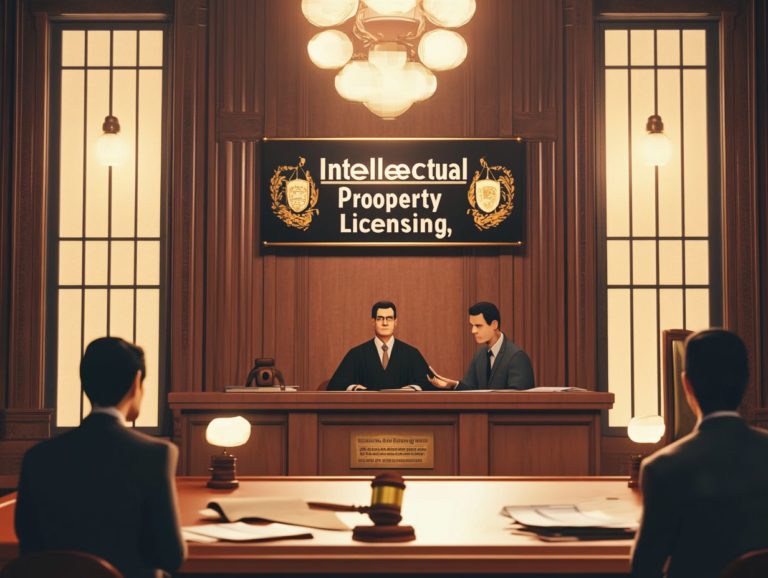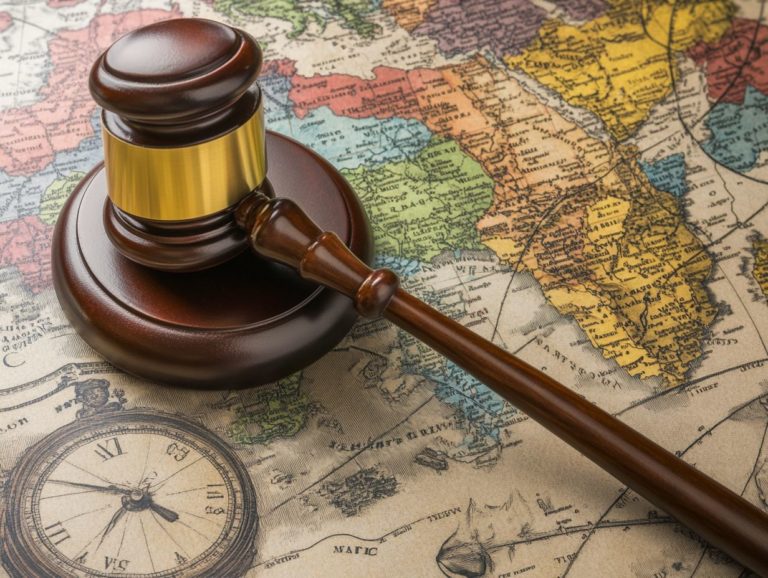Understanding Patent Infringement in Litigation
Patent infringement presents a complicated and often heated issue within the realm of intellectual property law.
As innovation accelerates, so do the difficulties in safeguarding your inventions. This article delves into the intricacies of patent infringement, starting with its definition and the various types direct and indirect.
You will discover how to prove infringement in a litigation context, explore the defenses at your disposal, and understand the potential remedies available if your patents are violated.
You will find practical tips designed for inventors and companies alike, aimed at steering clear of these legal pitfalls. Whether you are an inventor, a business owner, or simply interested in the nuances of patent law, this guide equips you with essential insights to navigate the complex landscape of patent infringement.
Contents
Key Takeaways:
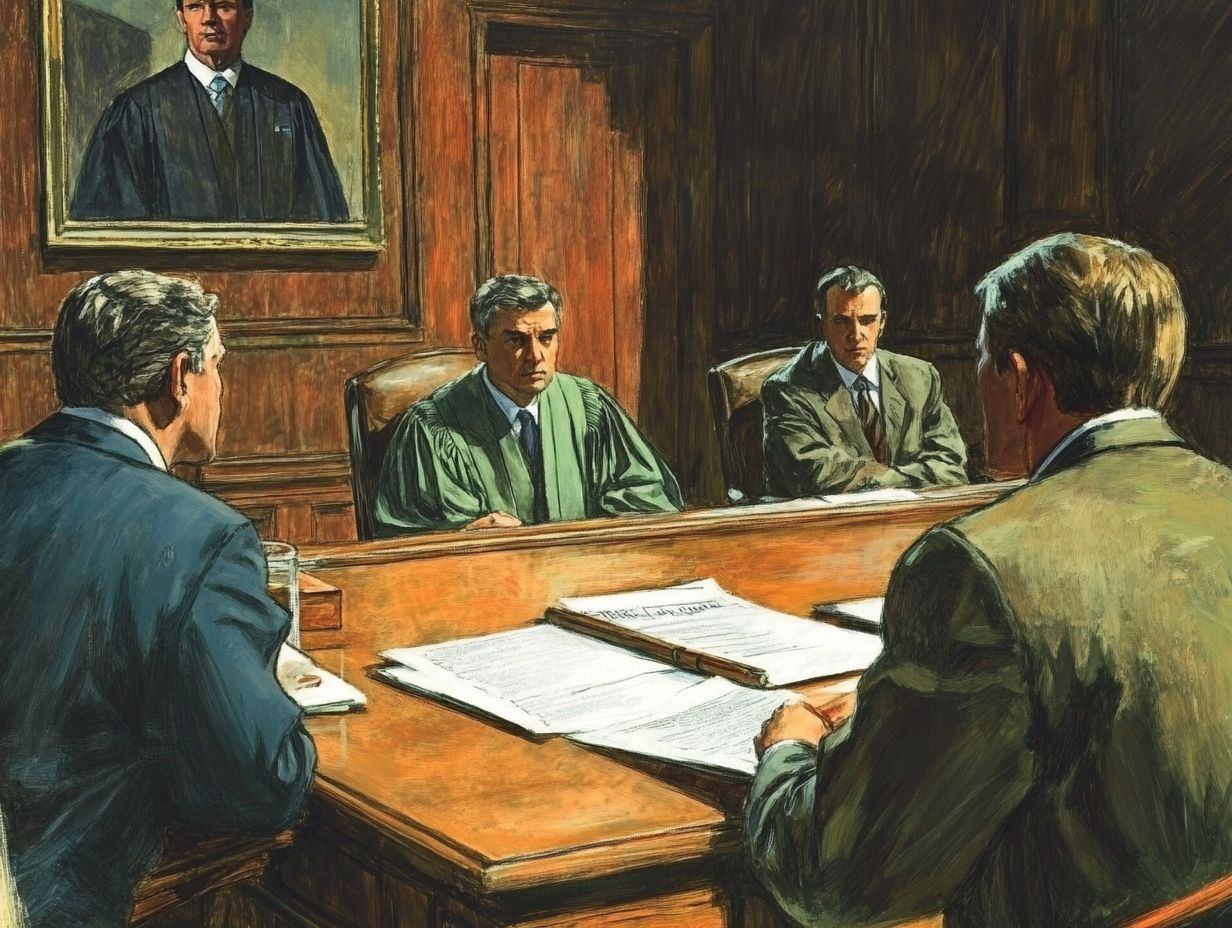
- Patent infringement is the unauthorized use, manufacture, or sale of a patented invention without the owner’s permission.
- There are two types of patent infringement: direct infringement and indirect infringement.
- To prove patent infringement in litigation, the patent owner must establish the elements of a claim and provide sufficient evidence to meet the responsibility to prove their case.
Overview of Patent Infringement
Patent infringement happens when you use, produce, or sell a patented invention without the consent of the patent holder, thereby violating the exclusive rights granted by the United States Patent and Trademark Office (USPTO).
This legal dilemma often escalates to litigation, where the plaintiff usually the patent holder pursues remedies for infringement claims. The consequences can be huge, leading to significant damages, injunctions, or royalties.
Such outcomes can have a profound impact on innovation and competition across diverse technology markets.
Defining Patent Infringement
Patent infringement refers to the unauthorized use of a patented invention, encompassing a range of infringement claims within the realm of intellectual property rights.
This unauthorized use can take several forms, including direct infringement, where someone uses, sells, or manufactures a patented product without permission, and indirect infringement, which occurs when someone contributes to or induces another party to infringe on patent rights.
Understanding these nuances is essential, as patent rights act as a protective shield for innovators, encouraging them to bring new ideas and technologies to market. By granting exclusive rights to inventors, the legal framework not only nurtures creativity but also fuels economic growth and competitiveness across various industries.
Without such protections in place, the fear of losing potential revenue and recognition could deter inventors from developing groundbreaking solutions.
Types of Patent Infringement
In U.S. law, you ll encounter two primary types of patent infringement: direct infringement and indirect infringement. Each presents its own set of challenges for patent holders striving to enforce their rights in federal court.
Direct Infringement
Direct infringement happens when you make, use, sell, or offer to sell a patented invention without the patent holder’s permission, which is a clear violation of patent rights. These actions can undermine the exclusivity granted to inventors and can lead to significant legal disputes.
Take, for instance, the case of Elekta AB v. O&M Halyard, Inc., where the court had to determine if the unauthorized manufacture of a medical device constituted direct infringement.
To prove direct infringement, you need to provide evidence that shows the alleged infringer has utilized the patented invention in a way specified by law. This typically involves patent claims, technical documentation, and expert testimonies, as demonstrated in numerous court decisions.
The outcomes of these cases can vary significantly, affecting not only the infringer, who may face financial penalties and injunctions, but also the patent holder, who could finally receive the recognition and compensation they rightfully deserve.
Indirect Infringement
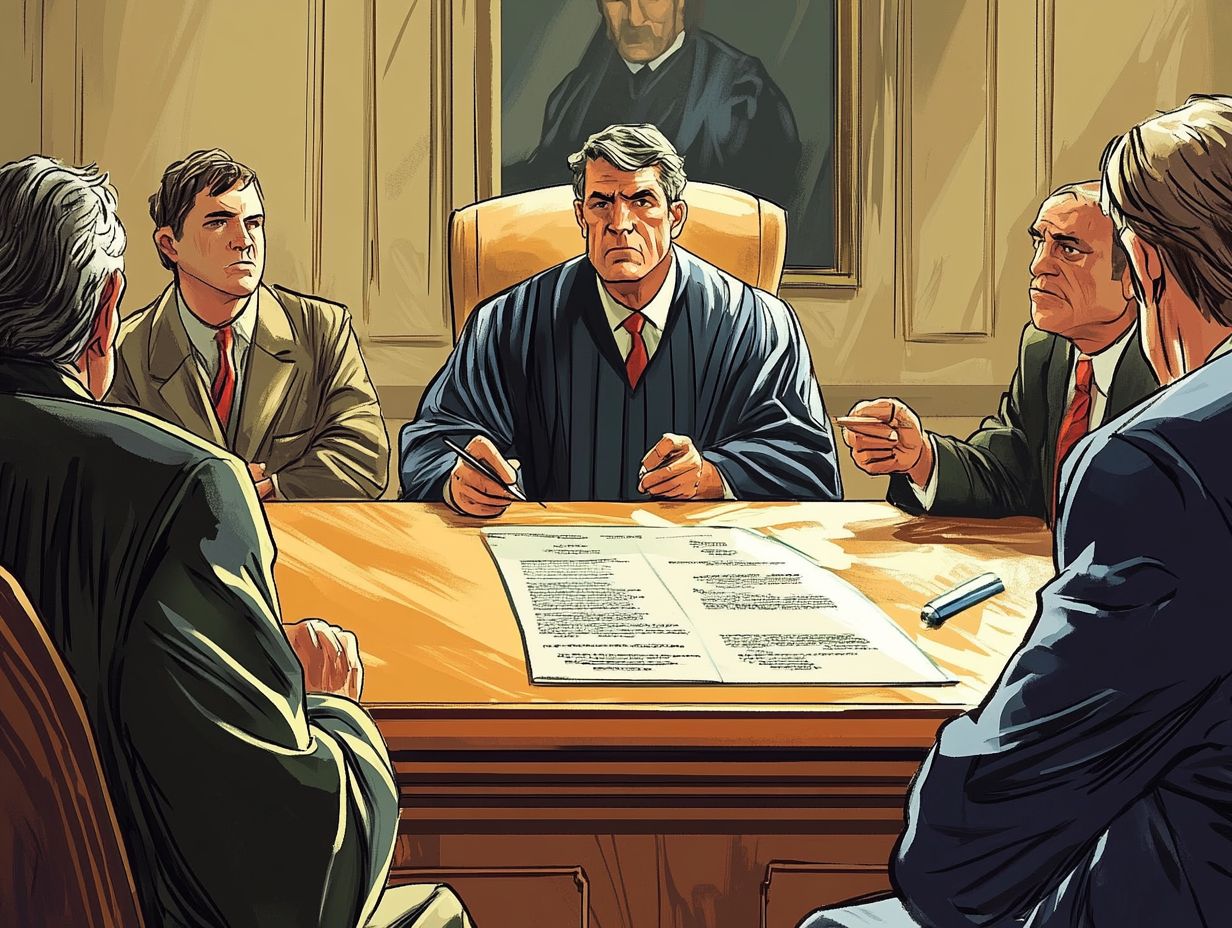
Indirect infringement occurs when you contribute to or induce another party to infringe a patent, even if you re not directly involved in the infringing activity yourself. This legal concept includes important details about two key types of liability: contributory infringement and induced infringement.
In contributory infringement, you might supply components or materials designed for infringing uses. If you manufacture tools intended for unlawful practices, legal consequences could follow.
Induced infringement typically involves actively encouraging someone else to infringe a patent. For example, a company might promote its product through advertisements that guide consumers on how to use it in an infringing manner.
Courts will scrutinize your intent and knowledge, making it crucial for you to understand the implications of your actions within the framework of patent law.
Proving Patent Infringement in Litigation
Proving patent infringement in litigation requires you to establish several critical elements of your claims with compelling evidence.
This approach ensures you meet the burden of proof required by the court.
Elements of a Patent Infringement Claim
The essential elements of a patent infringement claim require you to identify a valid patent, demonstrate that the defendant’s product or process falls within the claims of that patent, and show that the defendant had knowledge of the patent.
These components are crucial in determining whether infringement has occurred and are meticulously evaluated in court. For instance, courts typically demand a thorough examination of the patent’s validity, often referencing landmark cases like eBay Inc. v. MercExchange, where the Supreme Court underscored the significance of patent claims.
Establishing that a defendant’s actions fell within those claims can be complex. A notable example is the case of Markman v. Westview Instruments, which focused on interpreting patent terms.
To prove the defendant’s knowledge, you need to show that they were aware of the patent through direct communication or public records. This was illustrated in the litigation between Oracle and Google, which set a precedent for how knowledge influences infringement claims.
Evidence and Burden of Proof
In patent litigation, the burden of proof rests squarely on your shoulders as the plaintiff. You need to gather strong evidence fast to prove your case!
This critical requirement emphasizes the importance of comprehensive evidence, which can take various forms. For example, expert testimony can be a game-changer, with specialists offering insights into the technology involved and clarifying how it aligns with your patent claims.
Introducing prior art is crucial. It can reveal existing technologies or methodologies that may undermine the validity of the patent’s claims. Such evidence not only strengthens your position but also shapes the jury’s understanding, significantly influencing the case’s outcome.
Ultimately, the strength of the evidence you present will determine whether your infringement claims hold up under legal scrutiny.
Defenses Against Patent Infringement Claims
In patent infringement cases, you have the opportunity to assert various defenses. This includes challenging the validity of the patent itself and presenting arguments for non-infringement that focus on the specific details outlined in the patent claims.
Invalidity of Patent
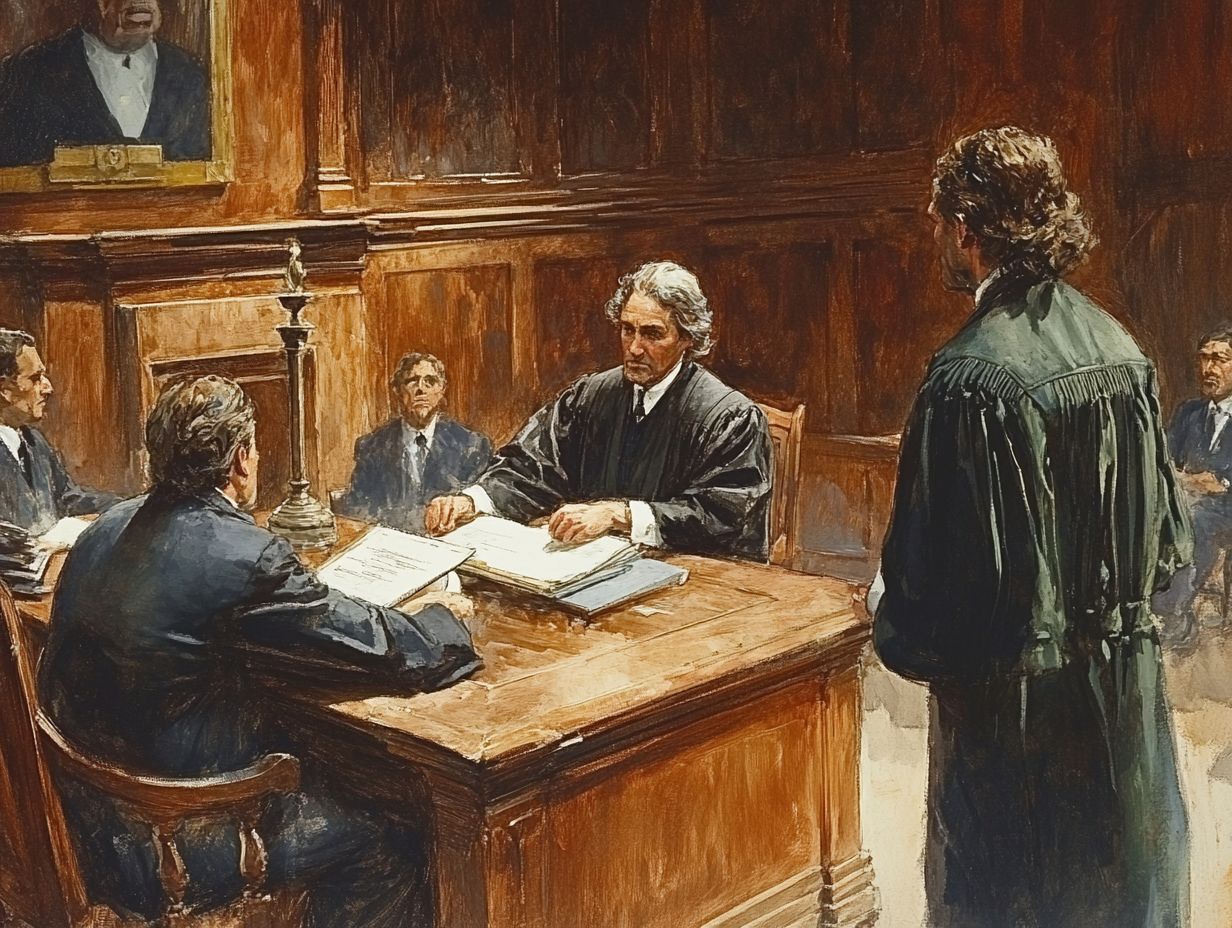
Claims of patent invalidity suggest that a patent should never have been granted, often due to previous inventions or ideas, lack of novelty, or failure to meet essential requirements of patentability. This assertion is crucial in ensuring only genuine innovations receive the protection they deserve, upholding the integrity of the patent system.
The United States Patent and Trademark Office (USPTO) serves as the vigilant gatekeeper during the patent prosecution process. They meticulously examine applications to ensure alignment with legal standards.
For instance, in KSR International Co. v. Teleflex Inc., the Supreme Court emphasized the necessity of rigorous patent examination, ultimately invalidating a patent on an adjustable gas pedal due to its obviousness. Similarly, in Alice Corp. v. CLS Bank International, the court nullified patents related to computer-implemented inventions, pointing to a lack of true innovation over existing technologies.
These cases clearly illustrated the importance of basing patent claims on authentic, novel contributions to the field.
Non-Infringement
Non-infringement defenses assert that the product or process in question does not fall within the scope of the patent claims, effectively negating any allegations of infringement. To establish this defense successfully, showcase how your products stand out by demonstrating distinct features or methods not covered by the patent’s claims.
Consider a notable case involving a software company accused of infringing a patented algorithm. The defendant convincingly proved that their technology employed a different coding structure, fundamentally altering its operation and falling outside the patent’s boundaries.
In another instance concerning a medical device, the court ruled in favor of the defendant after they showcased modifications to the device s functionality not present in the plaintiff s patent.
These examples illustrate how a meticulous examination of patent claims, combined with innovative engineering differences, can substantiate a robust claim of non-infringement.
Remedies for Patent Infringement
Remedies for patent infringement can include:
- Monetary damages
- Injunctive relief
- Payment of royalties
The specifics depend on the nature of the infringement and the court’s ruling, tailored to ensure justice is served effectively.
Damages and Injunctions
In patent litigation, damages are generally calculated based on either the lost profits of the patent holder or a reasonable royalty rate. Injunctions may also be granted to prevent further infringement, acting as a safeguard for the patent holder.
To accurately assess lost profits, evaluate a range of criteria meticulously. This includes understanding market demand for the patented product and estimating sales the patent holder could have achieved without infringement.
Robust evidence plays a pivotal role in this process; clear documentation and expert testimony are essential for illustrating the extent of financial losses incurred.
Injunctions are a formidable remedy. They compel the defendant to halt any infringing activities immediately. This action not only upholds the patent holder’s rights but can ripple through the market, potentially reducing competition and influencing consumer choices.
Avoiding Patent Infringement
To prevent patent infringement, it’s essential for you and your organization to embrace best practices:
- Conduct comprehensive patent searches
- Ensure full compliance with existing patents and intellectual property rights
By taking these proactive steps, you safeguard your innovations and foster a culture of respect for intellectual property.
Start your own patent search today or consult a legal expert to better understand your obligations and rights!
Best Practices for Companies and Inventors
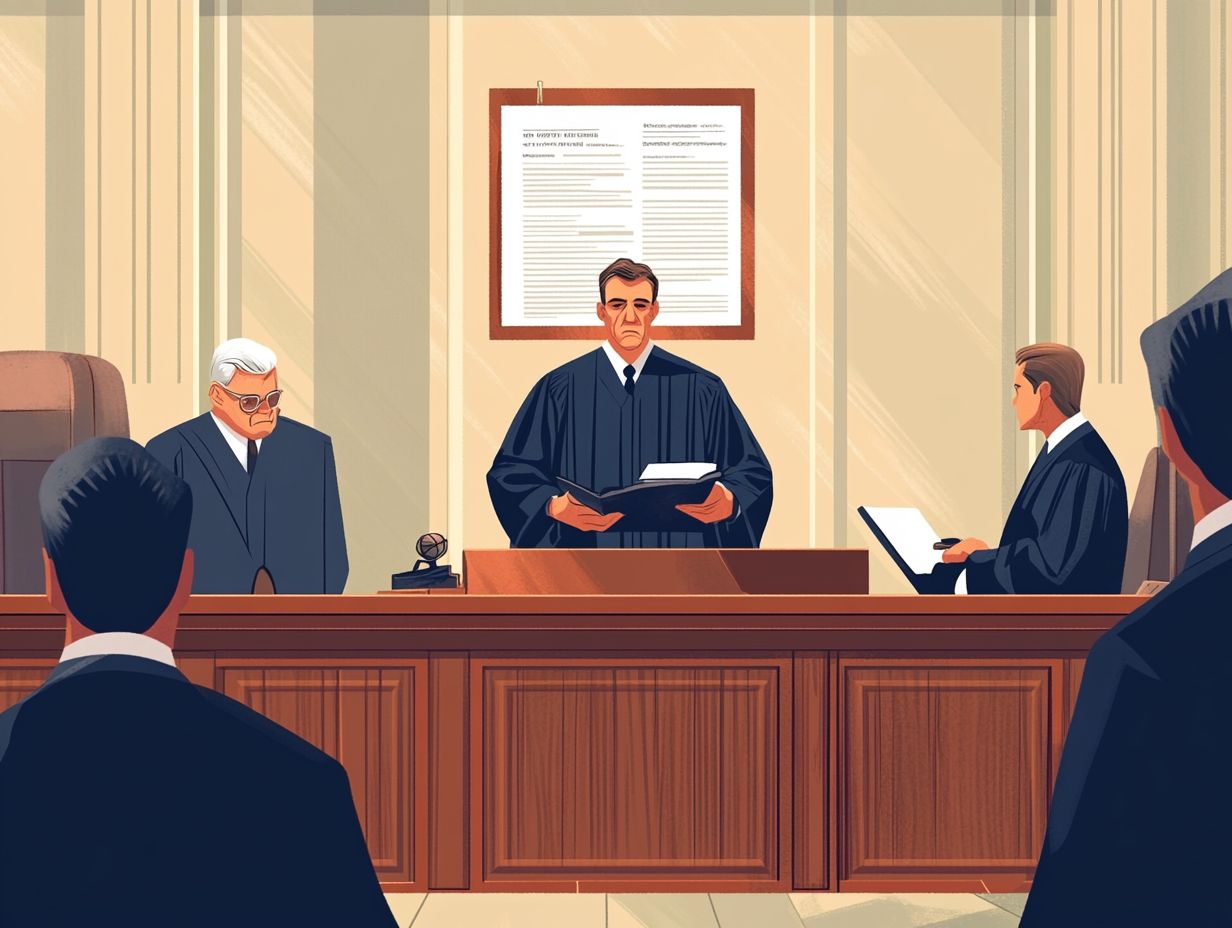
To avoid patent infringement, adopt best practices. Conduct regular patent searches and stay updated on patent laws. Seek legal counsel whenever necessary.
Utilizing resources from the United States Patent and Trademark Office (USPTO) can prove invaluable. By engaging in proactive patent prosecution, you can strengthen your patent collection and reduce the risks associated with potential disputes.
Understanding the changing market is crucial. It gives you the power to identify emerging technologies and potential competitors.
By developing a strategic approach to patent filings and closely monitoring your competitors activities, you enhance your organization s ability to understand patent law. This ensures compliance while fostering an environment of innovation.
Frequently Asked Questions
What is patent infringement in litigation?
Patent infringement in litigation refers to a legal claim made by a patent holder against another party for using, making, or selling a patented invention without permission, highlighting the importance of understanding the role of the court in IP litigation.
What is the purpose of a patent?
A patent is a legal protection granted to inventors for their original and useful inventions. It gives the inventor the exclusive right to make, use, and sell their invention for a limited period of time, usually 20 years.
What are the key factors of patent infringement?
The key factors include the existence of a valid patent and the accused party’s use, making, or selling of the patent without permission. Additionally, the similarity of the accused product or process to the patented invention is crucial.
What are the different types of patent infringement?
The two main types are literal infringement and doctrine of equivalents infringement. Literal infringement occurs when the accused product or process contains all of the elements of the patented invention.
Doctrine of equivalents infringement occurs when the accused product or process has minor differences but still performs the same function.
What are the consequences of patent infringement?
Patent infringement can lead to serious consequences! These may include financial damages, injunctions to stop the infringing activity, and, in some cases, criminal charges. The accused party may also be required to pay the patent holder’s legal fees.
How can I defend against a patent infringement claim?
If you are accused of patent infringement, you can defend against the claim by proving that the patent is invalid. Alternatively, show that the accused product or process does not infringe on the patent or that there is a valid legal defense, such as fair use or prior use.




